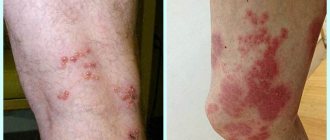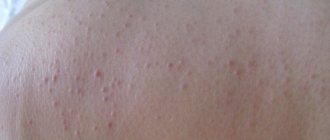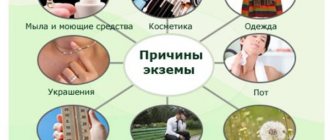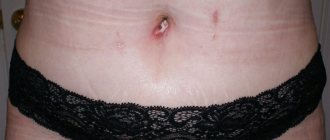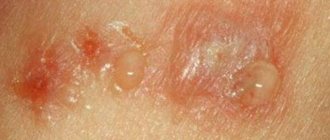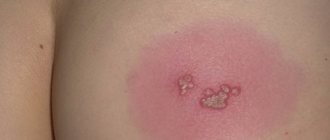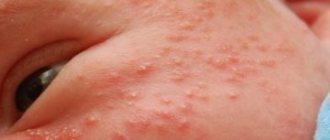Causes of Vulgar psoriasis
The clear causes of the pathology are unknown. Therefore, it is classified as a multifactorial type of dermatoses.
There are several hypotheses about the origin of the disease:
- Hereditary factor. Psoriasis is often diagnosed in the second, as well as the fifth and sixth generations. Inherited in a recessive and autosomal dominant manner.
- Impaired metabolism. As a rule, such patients have problems with the metabolism of enzymes, cholesterol and nucleic acids.
- Virus infection. The hypothesis is partially confirmed by experiments on rabbits that were injected with psoriatic material. However, a specific virus has not yet been discovered.
- Endocrine problems. Patients with psoriasis often suffer from disorders of the pituitary-adrenal system and have problems with the gonads.
- Psychological trauma. Some experts believe that psoriasis can be triggered by severe psychological trauma. This hypothesis is called neurogenic.
There are also factors that can serve as a favorable background for the occurrence of pathology:
- skin lesions;
- diabetes mellitus of any degree;
- atherosclerosis;
- interaction with harmful chemical elements;
- long course of certain medications.
Psoriasis most often affects males aged 20-25 years. Also at risk are mature people over 45 years of age. Photos of common plaque psoriasis will help you better understand what the pathology is.
Find out more
Factors of occurrence
The etiology of psoriasis is not fully understood. But it is believed that the main cause of the development of the disease is autoimmune malfunctions - disturbances in the functioning of the immune system, in which the produced antibodies accept their own cells as foreign and begin to fight them.
Cells begin to divide, grow and die at an accelerated pace, which leads to damage to the epidermis and, as a result, to the appearance and development of psoriasis.
The process of disease initiation can be influenced by the following provocateurs:
- hereditary predisposition (if someone in the family had psoriatic rashes, then there is a high probability of pathology);
- improper functioning of the endocrine system;
- violation of metabolic processes in the body (slow metabolism, poor absorption of vitamins, increased cholesterol levels and others);
- psychological shocks;
- parasitic infections;
- hormonal changes in the body;
- influence of drugs;
- prolonged exposure to the scorching sun;
- mechanical and chemical damage to the skin;
- infectious diseases.
Stages of progression of psoriasis vulgaris
There are three main stages of pathology:
- Progressive. The rashes appear periodically and have a specific erythematous rim, which, unlike the main part of the rash, is not covered with scales. The emerging papules gradually increase in size. After skin irritation, new papules may form (from exposure to the sun, after an injection or scratch, as a result of applying ointment). The rashes are very flaky (this feature of psoriasis vulgaris is well demonstrated in photos).
- Stationary. New papules do not appear, and existing formations remain constant in size and number. Skin peeling is moderate and severe. In case of skin irritation, new papules do not form. Sometimes a shiny whitish ring (Voronov's ring) may begin to form around the rash - this indicates that the disease has entered a regressive stage.
- Regressive. Peeling becomes smaller or disappears altogether. Plaques and rashes gradually disappear and smoothly turn into hypopigmentation (less often, on the contrary, into hyperpigmentation). In response to external irritation, new papas are not formed.
For different forms of plaque psoriasis, treatment strategies and principles may differ slightly.
The disease is characterized by a long course and frequent relapses. Attacks can recur up to 4-5 times a year. It often depends on the season:
- winter relapses - find the patient in the fall or winter;
- summer - the condition worsens in response to an increase in the amount of solar radiation;
- non-seasonal occurrence is the most severe option, when there is no obvious connection between the occurrence of the rash and the season.
In non-seasonal conditions, remissions are practically absent.
Diagnostics
As a rule, making a diagnosis of chronic plaque psoriasis is not problematic and is based on characteristic external signs. There are no blood tests or diagnostic procedures specifically designed for this disease.
With a progressive stage or extensive form of plaque psoriasis, it is possible to detect abnormalities in blood tests, on the basis of which the presence of an autoimmune, inflammatory, rheumatic process (leukocytosis, increased ESR, etc.) and endocrine and biochemical disorders are revealed.
To exclude other dermatological diseases and verify the diagnosis, a skin biopsy is sometimes performed. This reveals:
- thickening of the layer of keratocytes, their immaturity;
- symptoms of increased proliferation of keratocytes and immunocompetent cells;
- massive infiltration of damaged skin with T-lymphocytes, dendritic cells, macrophages;
- acceleration of angiogenesis (formation of new blood vessels) in the skin layer under psoriatic plaques.
Another typical symptom of chronic vulgar plaque psoriasis is the ease of bleeding when the plaque is scraped, as well as pinpoint bleeding. These phenomena are caused by accelerated angiogenesis and increased fragility and permeability of blood vessels in the affected areas of the skin (the so-called Auspitz symptom).
Symptoms of Vulgar psoriasis
The pathology develops slowly, and symptoms appear gradually.
The main features are as follows:
- single or multiple reddish papules, which can be combined into groups (rashes rise 1-2 mm above the skin);
- whitish or dull-gray scales on top of the rash (photos reflect this manifestation of plaque psoriasis to the greatest extent);
- intense itching, causing serious discomfort to the patient (when scratching, the skin is injured and the volume of rashes increases);
- increased skin sensitivity and soreness;
- the onset of the inflammatory process and a constant feeling of discomfort.
In some cases, a yellowish crust may form on the formations. Also, in some forms there is no peeling. More details about the manifestations of plaque psoriasis can be found in the photo.
If left untreated, the pathology progresses.
Prevention
There are no preventive measures to prevent vulgar psoriasis, but to reduce the frequency of exacerbations, you must follow some rules:
- regular monitoring of the disease;
- adherence to a dietary diet with limited consumption of carbohydrates, spicy, salty and smoked foods;
- consumption of a complex of vitamins and minerals (as prescribed);
- timely elimination of provoking factors;
- wearing clothes made from natural fabrics (avoid tight fit and friction);
- taking medicinal baths;
- use of sanatorium treatment;
- prevention of skin injuries;
- eliminating dry skin.
Treatment of vulgar psoriasis. Treatment Strategies
For vulgar psoriasis, there are several areas of treatment:
- Medicines for oral administration. In the form of tablets or injections. Usually these are hormone-containing drugs and medications to calm the symptoms. Injections are indicated for people with severe psoriasis and some patients with high blood pressure.
- External medicines. Designed to reduce the manifestations of the disease and improve the local protective functions of the skin. May take the form of an ointment, cream, gel or solution.
- Natural climatic treatment. In this case, the patient is prescribed natural sunbathing (twice a day for half an hour), as well as swimming in freshwater sources and salt water bodies. During periods of remission, mud and balneotherapy carried out in sanatoriums can be useful.
- Physiotherapy. As a rule, they resort to such means as electrosleep, ultraviolet irradiation, magnetic and magnetic laser therapy, and PUVA therapy.
- Psychotherapy. Classes with a psychologist or psychoneurologist are designed to relieve internal tension and help adapt to society. Auto-training and relaxing techniques are often used. Therapy can be done individually or in a group.
- Regime and diet. People with psoriasis are advised to avoid stress and maintain a healthy lifestyle. Good rest and sleep will be beneficial. The menu should avoid foods that have a stimulating effect on the nervous system (seasonings, sweets, alcohol). There are also two special power systems - Ognevaya and Pegano.
- Home remedies. Used as a supplement. Usually this is taking baths based on herbal mixtures, as well as taking herbal decoctions.
The course of therapy can take place at home or in a hospital setting. The latter type is indicated for patients with severe disease and low effectiveness of self-treatment.
Clinical picture
The disease is characterized by periods of exacerbations and remissions. Most often, infections and severe mental stress become the causes of exacerbations of skin pathology. It has been noticed that in winter, the condition of many patients worsens significantly. Clinical symptoms of psoriasis:
- Flat papules form on the skin, which are sharply demarcated from the healthy surface.
- Psoriatic papules are pink-red in color. On top of them are loose scales with a white-silver tint.
- A symptom of “stearin stain” is observed. After scraping the papules, their peeling intensifies. The surface resembles a drop of stearin.
- The symptom of “terminal film” is revealed. Having removed the scales from the psoriatic elements on the skin, a moist, shiny surface remains.
- The symptom of “blood dew” is determined. Continuing to scrape the surface of the elements, small droplets of blood are observed.
- Any area of the body can be affected by psoriatic plaques.
- Knees, elbows, and scalp are the favorite localization of the vulgar form of the disease.
What is a plaque in psoriasis? This is nothing more than a collection of scaly psoriatic papules, covered with a pale gray crust, and tending to grow peripherally. They come in various sizes and shapes. There are both isolated and large plaques that occupy large areas of the body.
Vulgar psoriasis. Treatment with folk remedies
Traditional recipes are used only as a supplement and only after discussion with the doctor. Otherwise, the condition may worsen, since not all natural components are combined with medications, and some can cause an allergic reaction (photos rarely show examples of such a reaction in vulgar psoriasis).
Most popular recipes:
- Sea buckthorn tincture. Sea buckthorn is poured with boiling water to obtain a medium or strong composition. Drink 30 drops three times a day.
- Valerian tincture. Take three times and one tablespoon every day. Instead of valerian, you can take any other natural sedative.
- Shift tincture. Take three-leaf watch, pour boiling water and leave for several hours. Take one-fourth glass twice a day.
- Solid oil ointment. Solid oil and celandine are mixed in a ratio of 5 to 1, respectively. The composition is applied to the affected areas 2-3 times a day.
- Viburnum juice. The juice is drunk pure or diluted in tea.
The listed recipes can be used simultaneously in combination.
How is treatment carried out at the Paramita Oriental Medicine Clinic?
But the first step on the path to getting rid of psoriatic plaques is a preliminary appointment with a specialist. At this appointment, the doctor will determine the nature of the disease, its stage of development, the degree of damage to the skin, and the possible causes of this disease in a particular patient.
Based on the data obtained during the survey - and, if necessary, a laboratory examination is also prescribed - the doctor determines the necessary treatment and prescribes a course of complex therapy sessions.
The cost of preliminary admission is 500 rubles.
Vulgar psoriasis. Prescribed medications
Basically, treatment for plaque psoriasis is carried out through external means. However, in severe or advanced cases, they resort to systemic medications.
The main types of medications are as follows:
- Corticosteroids. Hormone-containing compounds used in cases of severe symptoms. Due to the many side effects, they are prescribed only when absolutely necessary. They can take the form of both external and oral agents.
- Soothing gels and ointments. They differ from hormonal drugs in a longer period of time for results to arrive. However, they are effective and practically safe.
- Light sedatives for internal use. Designed to calm the nervous system and alleviate the psycho-emotional state of the patient.
- Anti-inflammatory drugs. In the form of ointment or tablets. Reduces symptomatic manifestations.
- Vitamin complexes. Especially with the content of DZ (aquadetrim). This helps restore immune strength and harmonize metabolic processes. Most often prescribed in the form of ointments and creams.
The products are used in combination. Only a specialist can prescribe suitable medications.
Description and features of dermatosis
In another way, vulgar psoriasis is called plaque or simple. It is this that manifests itself on the skin by the formation of papules that have clear boundaries, and is diagnosed in almost 90 percent of all cases of registered dermatosis. Typically, skin tags that form are pink and reddish raised patches covered with yellowish or gray flakes of dead skin. Plaque psoriasis most often has a mild course. Exacerbations during progression rarely occur with the correct approach to treatment. However, there are cases of significant damage to the skin, when pink spots covered large areas of the skin and were practically impossible to eliminate.
The skin in the area of papules has increased vulnerability due to the proximity of blood vessels on the surface. Therefore, she does not tolerate injury or scratching.
Preventive measures
The key measures are:
- Do not worry. The less stress, the more balanced the nervous system functions.
- Wear the right clothes. It should be loose-fitting and made from natural materials. The tighter the clothes, the more the skin is injured.
- Follow a diet. With psoriasis, the diet is followed throughout life.
- Take medication. However, only in consultation with the doctor.
- Don't neglect the shower or bath. It is advisable to take them daily. It is better to use mild cleansers without sulfates in the composition. Baby or tar soap are also suitable.
- Take care of your skin. Regular application of moisturizers and soothing products will alleviate skin conditions.
By following these recommendations, the risk of relapse is significantly reduced.
Possible complications of a dermatological problem
Extensive damage to the skin during the progression of the disease is not the only complication of the pathology. Along with this, patients may develop:
- Psoriatic arthritis (joint pathology);
- Disruption of the cardiovascular system;
- Kidney diseases;
- Damage to the liver and digestive system;
- Changes in the structure of the nail plates.
An important factor in preventing complications is timely diagnosis and treatment of common psoriasis.
Development of pathology
Psoriasis is a serious violation of the natural regeneration of cells located in the upper layers of the skin. If in a normal state these elements are updated once every three weeks, in pathology it takes much less time, approximately once every 4-6 days.
The cells located in the stratum corneum become not fully developed and, accordingly, do not cope with their purpose.
As a result of such deviations, natural intercellular connections are lost. The upper layers of the skin cannot form naturally and are unable to take root. This automatically causes such unpleasant phenomena as:
- Formation of pustules;
- The appearance of papules;
- Multiple plaques.
Excessive angiogenesis is present in these formations. Many tiny vessels appear. In addition, the skin takes on an extremely unattractive appearance.
